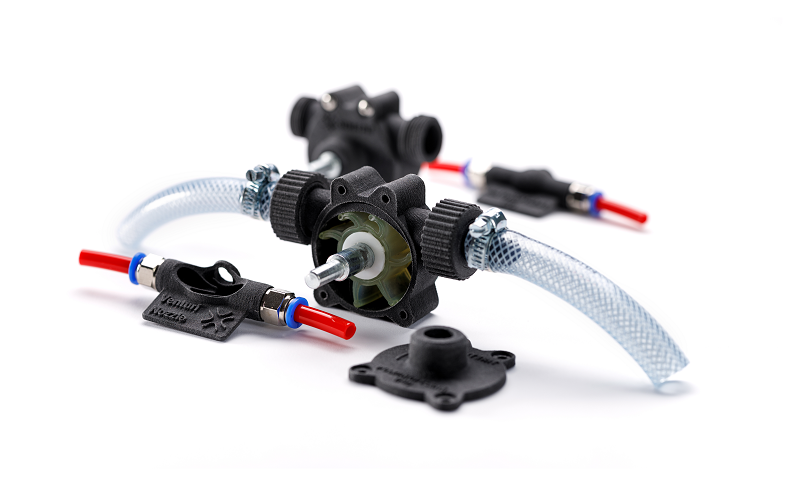In the fall of 2020, Polish desktop SLS 3D printing company Sinterit introduced PA11 ESD, the seventh material in its powder portfolio. Sinterit is a firm believer in the necessity of offering a wide, diverse range of SLS powder materials: because prototyping is one of the most common applications for 3D printing, and, as Sinterit said, specifically selective laser sintering technology, “the demand for the diversified material portfolio is something even more significant than the need for speed.” As such, the company is now launching something it says the AM industry has been waiting for: the first polypropylene (PP) material for compact SLS 3D printing. Sinterit’s latest powder material will increase the application possibilities for plastic parts producers, automotive manufacturers, and more.
Until now, at least according to Sinterit’s press release, the only air and watertight material available for SLS 3D printing was its own TPE, but even this wasn’t the best option, as parts required a special sealer to be applied post-printing. The company’s new PP powder, based on a chemical-resistant material with low water absorption, is somewhat distinctive for compact SLS 3D printers. Additionally, the final sealing step is not required with Sinterit’s new PP.
In terms of material properties, the PP powder has a tensile strength of 19.3 MPa, a softening point of 119°C, elongation at a break of 44%, and 820 MPa Young’s modulus. Available in metal buckets that can hold 6 kg worth of powder, the material comes in gray. Because of its lower density, this new PP powder can create buoyant prototype parts, like pumps that have to be able to work in water or other fluid environments. That’s because the material doesn’t uptake moisture, and can also withstand the increased pressure of being submerged.
A variety of car parts are made using polypropylene, which makes this powder suitable for automotive applications, such as functional prototypes and air filter housings.
Konrad Głowacki, Sinterit co-founder and Chief Business Development Officer, said, “Our PP is suitable for functional prototyping of the ducting in the air intake, fan shrouds and electronic housings.
“Those applications are now available because of PP’s standard usage and its properties.”
Sinterit’s latest powder material can also be used by plastic parts producers to print a lot of commodity parts, and the company says that pairing this new PP with its Lisa or Lisa PRO systems can then “enable them for faster prototyping and short series production of final products.”
Finally, another possible application for Sinterit’s new PP powder includes R&D companies and university labs that are working with pneumatics. Sinterit says that PP, unlike most other SLS polymer materials, is able to hold up well under the pressurization of typical pneumatic systems, so it’s a good choice for 3D printing parts like junctions, sensor housings, and custom adapters. Additionally, the company’s Lisa and LISA PRO 3D printers feature open parameters, so this would be a good solution for research centers and labs, “which have no use of the printers working in a close environment.”
Sinterit is working to making SLS 3D printing more accessible to the industry, and this new PP powder material should be a good next step towards this goal.
(Source/Images: Sinterit)
Subscribe to Our Email Newsletter
Stay up-to-date on all the latest news from the 3D printing industry and receive information and offers from third party vendors.
Print Services
Upload your 3D Models and get them printed quickly and efficiently.
You May Also Like
3D Printing News Briefs, June 11, 2025: Sustainability, Automotive Tooling, & More
We’re starting with sustainability news in today’s 3D Printing News Briefs, as EOS has strengthened its commitment on climate responsibility, and Zestep is making 3D printing filament out of eyewear...
3D Printing 50 Polymer Stand-In Parts for Tokamaks at the PPPL & Elytt Energy
Of all the world’s things, a tokamak is one of the hardest, most complex, expensive and exacting ones to make. These fusion energy devices make plasma, and use magnets to...
3D Printing News Briefs, May 17, 2025: Color-Changing Materials, Humanoid Robot, & More
We’re covering research innovations in today’s 3D Printing News Briefs! First, Penn Engineering developed 3D printed materials that change color under stress, and UC Berkeley researchers created an open source,...
Firehawk Aerospace Partners with JuggerBot 3D, Gets $1.25M from AFWERX for 3D Printed Propellants
Texas-based Firehawk Aerospace, an advanced energetic materials firm that works with aerospace and defense applications, announced a strategic partnership with JuggerBot 3D, an Ohio-based large-format 3D printer manufacturer. Together, the...




































